Detailed Report: Understanding Food Additives and Preservatives
VerifiedAdded on 2022/04/26
|26
|8178
|42
Report
AI Summary
This report provides a comprehensive introduction to food additives and preservatives. It begins by defining these substances and highlighting their historical use, including methods like smoking, salting, and pickling. The report then delves into the various categories of food additives, such as acidity regulators, antioxidants, bulking agents, colorings, and preservatives, explaining their specific functions. It also explores the different uses of food additives, which include maintaining nutritional value, enhancing product quality, and controlling pH levels. The report categorizes additives based on their function, such as thickening agents, chelating agents, and antimicrobial agents. Furthermore, it discusses the purpose of food additives, distinguishing between direct and indirect additives and emphasizing their role in ensuring food safety and abundance. The report concludes by referencing the regulatory oversight provided by the FDA and the importance of these additives in the modern food industry.
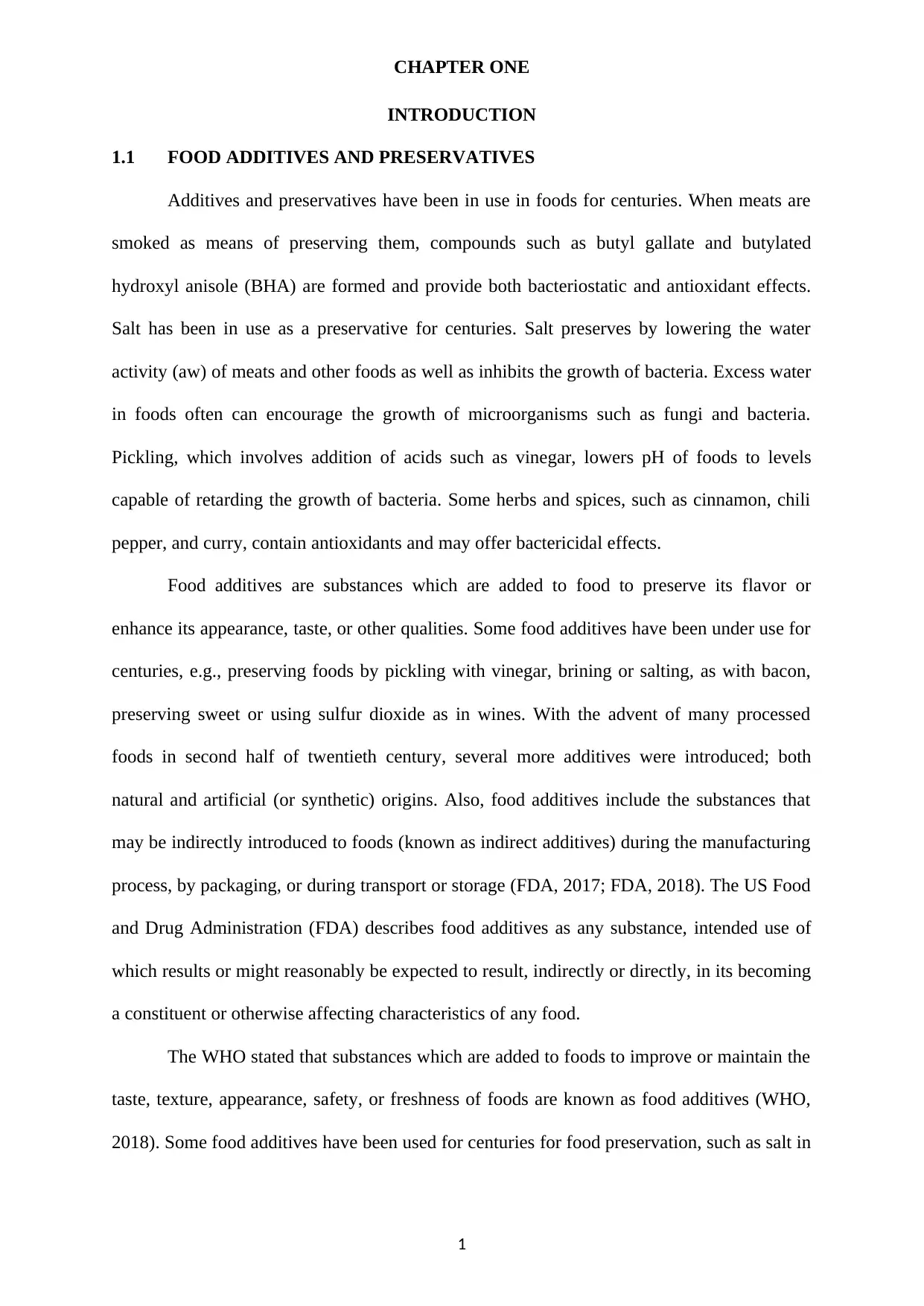
CHAPTER ONE
INTRODUCTION
1.1 FOOD ADDITIVES AND PRESERVATIVES
Additives and preservatives have been in use in foods for centuries. When meats are
smoked as means of preserving them, compounds such as butyl gallate and butylated
hydroxyl anisole (BHA) are formed and provide both bacteriostatic and antioxidant effects.
Salt has been in use as a preservative for centuries. Salt preserves by lowering the water
activity (aw) of meats and other foods as well as inhibits the growth of bacteria. Excess water
in foods often can encourage the growth of microorganisms such as fungi and bacteria.
Pickling, which involves addition of acids such as vinegar, lowers pH of foods to levels
capable of retarding the growth of bacteria. Some herbs and spices, such as cinnamon, chili
pepper, and curry, contain antioxidants and may offer bactericidal effects.
Food additives are substances which are added to food to preserve its flavor or
enhance its appearance, taste, or other qualities. Some food additives have been under use for
centuries, e.g., preserving foods by pickling with vinegar, brining or salting, as with bacon,
preserving sweet or using sulfur dioxide as in wines. With the advent of many processed
foods in second half of twentieth century, several more additives were introduced; both
natural and artificial (or synthetic) origins. Also, food additives include the substances that
may be indirectly introduced to foods (known as indirect additives) during the manufacturing
process, by packaging, or during transport or storage (FDA, 2017; FDA, 2018). The US Food
and Drug Administration (FDA) describes food additives as any substance, intended use of
which results or might reasonably be expected to result, indirectly or directly, in its becoming
a constituent or otherwise affecting characteristics of any food.
The WHO stated that substances which are added to foods to improve or maintain the
taste, texture, appearance, safety, or freshness of foods are known as food additives (WHO,
2018). Some food additives have been used for centuries for food preservation, such as salt in
1
INTRODUCTION
1.1 FOOD ADDITIVES AND PRESERVATIVES
Additives and preservatives have been in use in foods for centuries. When meats are
smoked as means of preserving them, compounds such as butyl gallate and butylated
hydroxyl anisole (BHA) are formed and provide both bacteriostatic and antioxidant effects.
Salt has been in use as a preservative for centuries. Salt preserves by lowering the water
activity (aw) of meats and other foods as well as inhibits the growth of bacteria. Excess water
in foods often can encourage the growth of microorganisms such as fungi and bacteria.
Pickling, which involves addition of acids such as vinegar, lowers pH of foods to levels
capable of retarding the growth of bacteria. Some herbs and spices, such as cinnamon, chili
pepper, and curry, contain antioxidants and may offer bactericidal effects.
Food additives are substances which are added to food to preserve its flavor or
enhance its appearance, taste, or other qualities. Some food additives have been under use for
centuries, e.g., preserving foods by pickling with vinegar, brining or salting, as with bacon,
preserving sweet or using sulfur dioxide as in wines. With the advent of many processed
foods in second half of twentieth century, several more additives were introduced; both
natural and artificial (or synthetic) origins. Also, food additives include the substances that
may be indirectly introduced to foods (known as indirect additives) during the manufacturing
process, by packaging, or during transport or storage (FDA, 2017; FDA, 2018). The US Food
and Drug Administration (FDA) describes food additives as any substance, intended use of
which results or might reasonably be expected to result, indirectly or directly, in its becoming
a constituent or otherwise affecting characteristics of any food.
The WHO stated that substances which are added to foods to improve or maintain the
taste, texture, appearance, safety, or freshness of foods are known as food additives (WHO,
2018). Some food additives have been used for centuries for food preservation, such as salt in
1
Paraphrase This Document
Need a fresh take? Get an instant paraphrase of this document with our AI Paraphraser
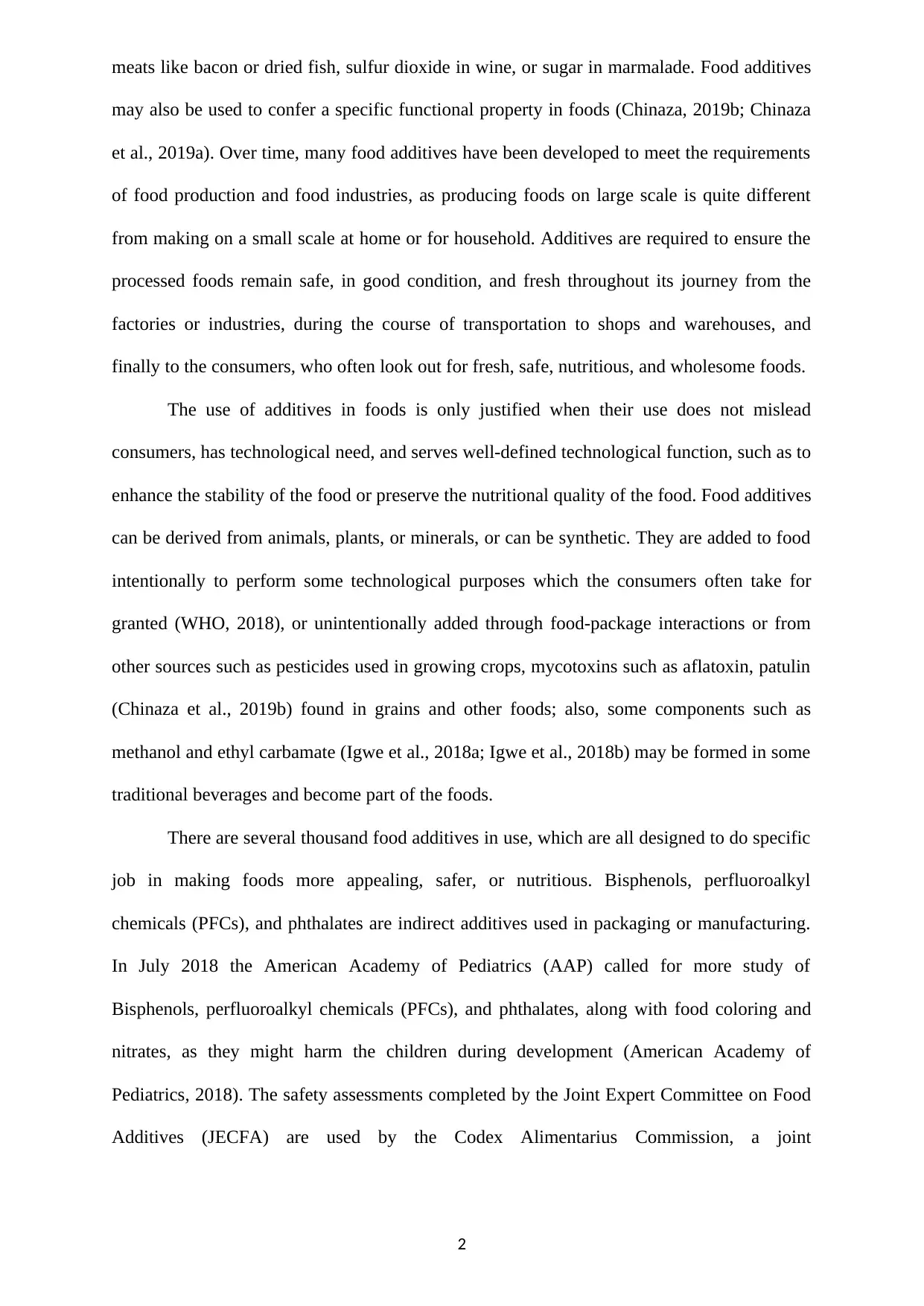
meats like bacon or dried fish, sulfur dioxide in wine, or sugar in marmalade. Food additives
may also be used to confer a specific functional property in foods (Chinaza, 2019b; Chinaza
et al., 2019a). Over time, many food additives have been developed to meet the requirements
of food production and food industries, as producing foods on large scale is quite different
from making on a small scale at home or for household. Additives are required to ensure the
processed foods remain safe, in good condition, and fresh throughout its journey from the
factories or industries, during the course of transportation to shops and warehouses, and
finally to the consumers, who often look out for fresh, safe, nutritious, and wholesome foods.
The use of additives in foods is only justified when their use does not mislead
consumers, has technological need, and serves well-defined technological function, such as to
enhance the stability of the food or preserve the nutritional quality of the food. Food additives
can be derived from animals, plants, or minerals, or can be synthetic. They are added to food
intentionally to perform some technological purposes which the consumers often take for
granted (WHO, 2018), or unintentionally added through food-package interactions or from
other sources such as pesticides used in growing crops, mycotoxins such as aflatoxin, patulin
(Chinaza et al., 2019b) found in grains and other foods; also, some components such as
methanol and ethyl carbamate (Igwe et al., 2018a; Igwe et al., 2018b) may be formed in some
traditional beverages and become part of the foods.
There are several thousand food additives in use, which are all designed to do specific
job in making foods more appealing, safer, or nutritious. Bisphenols, perfluoroalkyl
chemicals (PFCs), and phthalates are indirect additives used in packaging or manufacturing.
In July 2018 the American Academy of Pediatrics (AAP) called for more study of
Bisphenols, perfluoroalkyl chemicals (PFCs), and phthalates, along with food coloring and
nitrates, as they might harm the children during development (American Academy of
Pediatrics, 2018). The safety assessments completed by the Joint Expert Committee on Food
Additives (JECFA) are used by the Codex Alimentarius Commission, a joint
2
may also be used to confer a specific functional property in foods (Chinaza, 2019b; Chinaza
et al., 2019a). Over time, many food additives have been developed to meet the requirements
of food production and food industries, as producing foods on large scale is quite different
from making on a small scale at home or for household. Additives are required to ensure the
processed foods remain safe, in good condition, and fresh throughout its journey from the
factories or industries, during the course of transportation to shops and warehouses, and
finally to the consumers, who often look out for fresh, safe, nutritious, and wholesome foods.
The use of additives in foods is only justified when their use does not mislead
consumers, has technological need, and serves well-defined technological function, such as to
enhance the stability of the food or preserve the nutritional quality of the food. Food additives
can be derived from animals, plants, or minerals, or can be synthetic. They are added to food
intentionally to perform some technological purposes which the consumers often take for
granted (WHO, 2018), or unintentionally added through food-package interactions or from
other sources such as pesticides used in growing crops, mycotoxins such as aflatoxin, patulin
(Chinaza et al., 2019b) found in grains and other foods; also, some components such as
methanol and ethyl carbamate (Igwe et al., 2018a; Igwe et al., 2018b) may be formed in some
traditional beverages and become part of the foods.
There are several thousand food additives in use, which are all designed to do specific
job in making foods more appealing, safer, or nutritious. Bisphenols, perfluoroalkyl
chemicals (PFCs), and phthalates are indirect additives used in packaging or manufacturing.
In July 2018 the American Academy of Pediatrics (AAP) called for more study of
Bisphenols, perfluoroalkyl chemicals (PFCs), and phthalates, along with food coloring and
nitrates, as they might harm the children during development (American Academy of
Pediatrics, 2018). The safety assessments completed by the Joint Expert Committee on Food
Additives (JECFA) are used by the Codex Alimentarius Commission, a joint
2
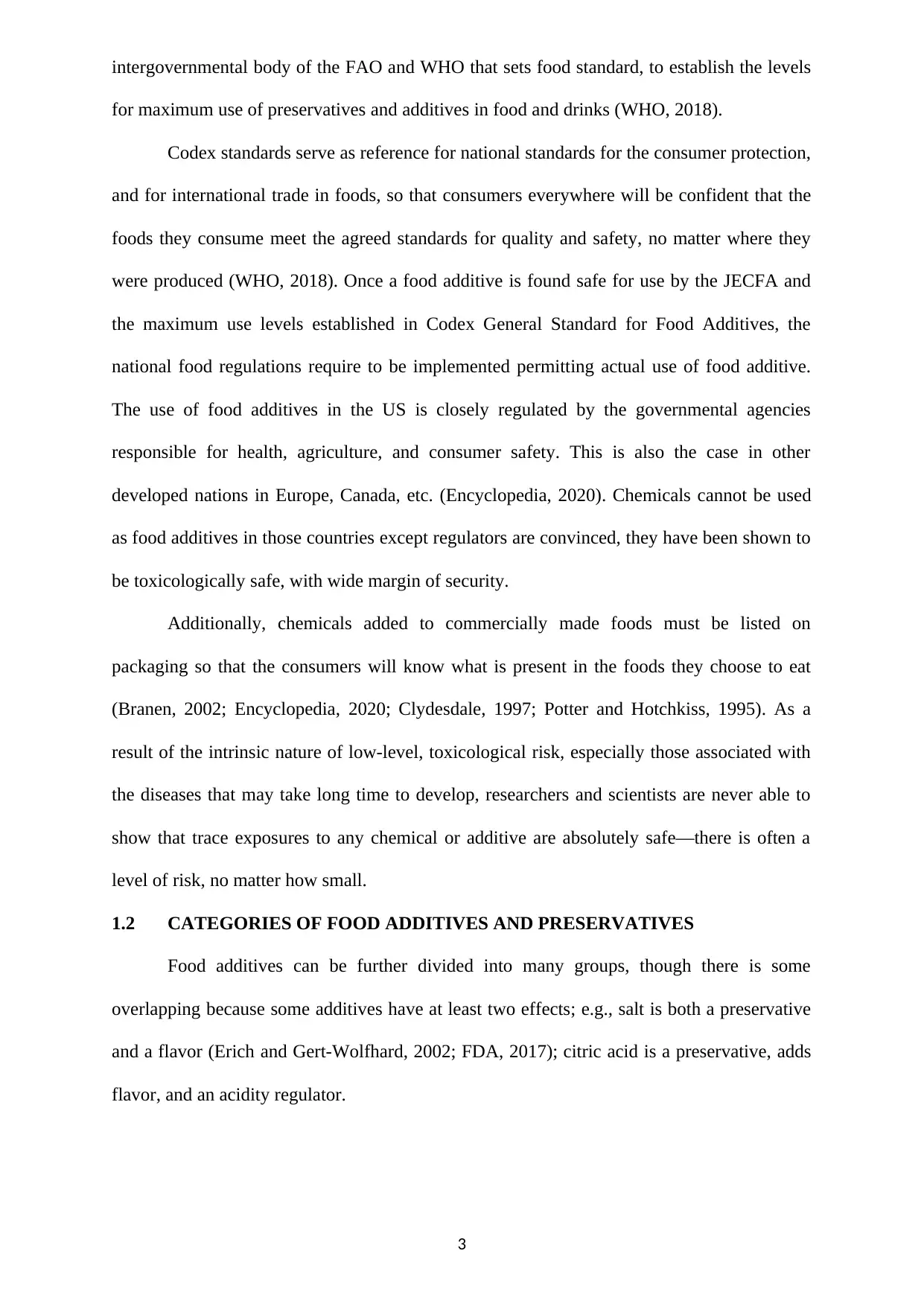
intergovernmental body of the FAO and WHO that sets food standard, to establish the levels
for maximum use of preservatives and additives in food and drinks (WHO, 2018).
Codex standards serve as reference for national standards for the consumer protection,
and for international trade in foods, so that consumers everywhere will be confident that the
foods they consume meet the agreed standards for quality and safety, no matter where they
were produced (WHO, 2018). Once a food additive is found safe for use by the JECFA and
the maximum use levels established in Codex General Standard for Food Additives, the
national food regulations require to be implemented permitting actual use of food additive.
The use of food additives in the US is closely regulated by the governmental agencies
responsible for health, agriculture, and consumer safety. This is also the case in other
developed nations in Europe, Canada, etc. (Encyclopedia, 2020). Chemicals cannot be used
as food additives in those countries except regulators are convinced, they have been shown to
be toxicologically safe, with wide margin of security.
Additionally, chemicals added to commercially made foods must be listed on
packaging so that the consumers will know what is present in the foods they choose to eat
(Branen, 2002; Encyclopedia, 2020; Clydesdale, 1997; Potter and Hotchkiss, 1995). As a
result of the intrinsic nature of low-level, toxicological risk, especially those associated with
the diseases that may take long time to develop, researchers and scientists are never able to
show that trace exposures to any chemical or additive are absolutely safe—there is often a
level of risk, no matter how small.
1.2 CATEGORIES OF FOOD ADDITIVES AND PRESERVATIVES
Food additives can be further divided into many groups, though there is some
overlapping because some additives have at least two effects; e.g., salt is both a preservative
and a flavor (Erich and Gert-Wolfhard, 2002; FDA, 2017); citric acid is a preservative, adds
flavor, and an acidity regulator.
3
for maximum use of preservatives and additives in food and drinks (WHO, 2018).
Codex standards serve as reference for national standards for the consumer protection,
and for international trade in foods, so that consumers everywhere will be confident that the
foods they consume meet the agreed standards for quality and safety, no matter where they
were produced (WHO, 2018). Once a food additive is found safe for use by the JECFA and
the maximum use levels established in Codex General Standard for Food Additives, the
national food regulations require to be implemented permitting actual use of food additive.
The use of food additives in the US is closely regulated by the governmental agencies
responsible for health, agriculture, and consumer safety. This is also the case in other
developed nations in Europe, Canada, etc. (Encyclopedia, 2020). Chemicals cannot be used
as food additives in those countries except regulators are convinced, they have been shown to
be toxicologically safe, with wide margin of security.
Additionally, chemicals added to commercially made foods must be listed on
packaging so that the consumers will know what is present in the foods they choose to eat
(Branen, 2002; Encyclopedia, 2020; Clydesdale, 1997; Potter and Hotchkiss, 1995). As a
result of the intrinsic nature of low-level, toxicological risk, especially those associated with
the diseases that may take long time to develop, researchers and scientists are never able to
show that trace exposures to any chemical or additive are absolutely safe—there is often a
level of risk, no matter how small.
1.2 CATEGORIES OF FOOD ADDITIVES AND PRESERVATIVES
Food additives can be further divided into many groups, though there is some
overlapping because some additives have at least two effects; e.g., salt is both a preservative
and a flavor (Erich and Gert-Wolfhard, 2002; FDA, 2017); citric acid is a preservative, adds
flavor, and an acidity regulator.
3
⊘ This is a preview!⊘
Do you want full access?
Subscribe today to unlock all pages.

Trusted by 1+ million students worldwide
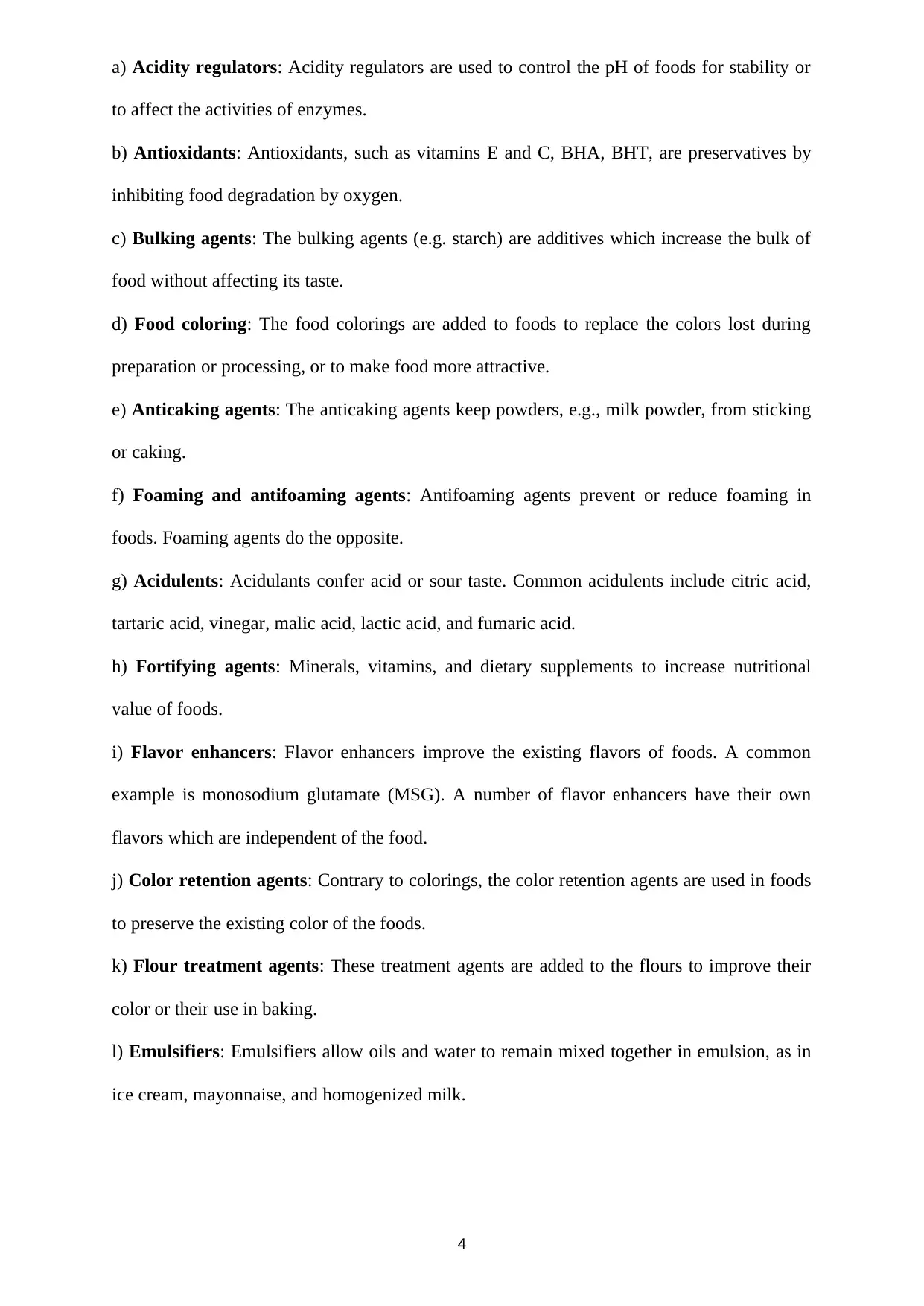
a) Acidity regulators: Acidity regulators are used to control the pH of foods for stability or
to affect the activities of enzymes.
b) Antioxidants: Antioxidants, such as vitamins E and C, BHA, BHT, are preservatives by
inhibiting food degradation by oxygen.
c) Bulking agents: The bulking agents (e.g. starch) are additives which increase the bulk of
food without affecting its taste.
d) Food coloring: The food colorings are added to foods to replace the colors lost during
preparation or processing, or to make food more attractive.
e) Anticaking agents: The anticaking agents keep powders, e.g., milk powder, from sticking
or caking.
f) Foaming and antifoaming agents: Antifoaming agents prevent or reduce foaming in
foods. Foaming agents do the opposite.
g) Acidulents: Acidulants confer acid or sour taste. Common acidulents include citric acid,
tartaric acid, vinegar, malic acid, lactic acid, and fumaric acid.
h) Fortifying agents: Minerals, vitamins, and dietary supplements to increase nutritional
value of foods.
i) Flavor enhancers: Flavor enhancers improve the existing flavors of foods. A common
example is monosodium glutamate (MSG). A number of flavor enhancers have their own
flavors which are independent of the food.
j) Color retention agents: Contrary to colorings, the color retention agents are used in foods
to preserve the existing color of the foods.
k) Flour treatment agents: These treatment agents are added to the flours to improve their
color or their use in baking.
l) Emulsifiers: Emulsifiers allow oils and water to remain mixed together in emulsion, as in
ice cream, mayonnaise, and homogenized milk.
4
to affect the activities of enzymes.
b) Antioxidants: Antioxidants, such as vitamins E and C, BHA, BHT, are preservatives by
inhibiting food degradation by oxygen.
c) Bulking agents: The bulking agents (e.g. starch) are additives which increase the bulk of
food without affecting its taste.
d) Food coloring: The food colorings are added to foods to replace the colors lost during
preparation or processing, or to make food more attractive.
e) Anticaking agents: The anticaking agents keep powders, e.g., milk powder, from sticking
or caking.
f) Foaming and antifoaming agents: Antifoaming agents prevent or reduce foaming in
foods. Foaming agents do the opposite.
g) Acidulents: Acidulants confer acid or sour taste. Common acidulents include citric acid,
tartaric acid, vinegar, malic acid, lactic acid, and fumaric acid.
h) Fortifying agents: Minerals, vitamins, and dietary supplements to increase nutritional
value of foods.
i) Flavor enhancers: Flavor enhancers improve the existing flavors of foods. A common
example is monosodium glutamate (MSG). A number of flavor enhancers have their own
flavors which are independent of the food.
j) Color retention agents: Contrary to colorings, the color retention agents are used in foods
to preserve the existing color of the foods.
k) Flour treatment agents: These treatment agents are added to the flours to improve their
color or their use in baking.
l) Emulsifiers: Emulsifiers allow oils and water to remain mixed together in emulsion, as in
ice cream, mayonnaise, and homogenized milk.
4
Paraphrase This Document
Need a fresh take? Get an instant paraphrase of this document with our AI Paraphraser
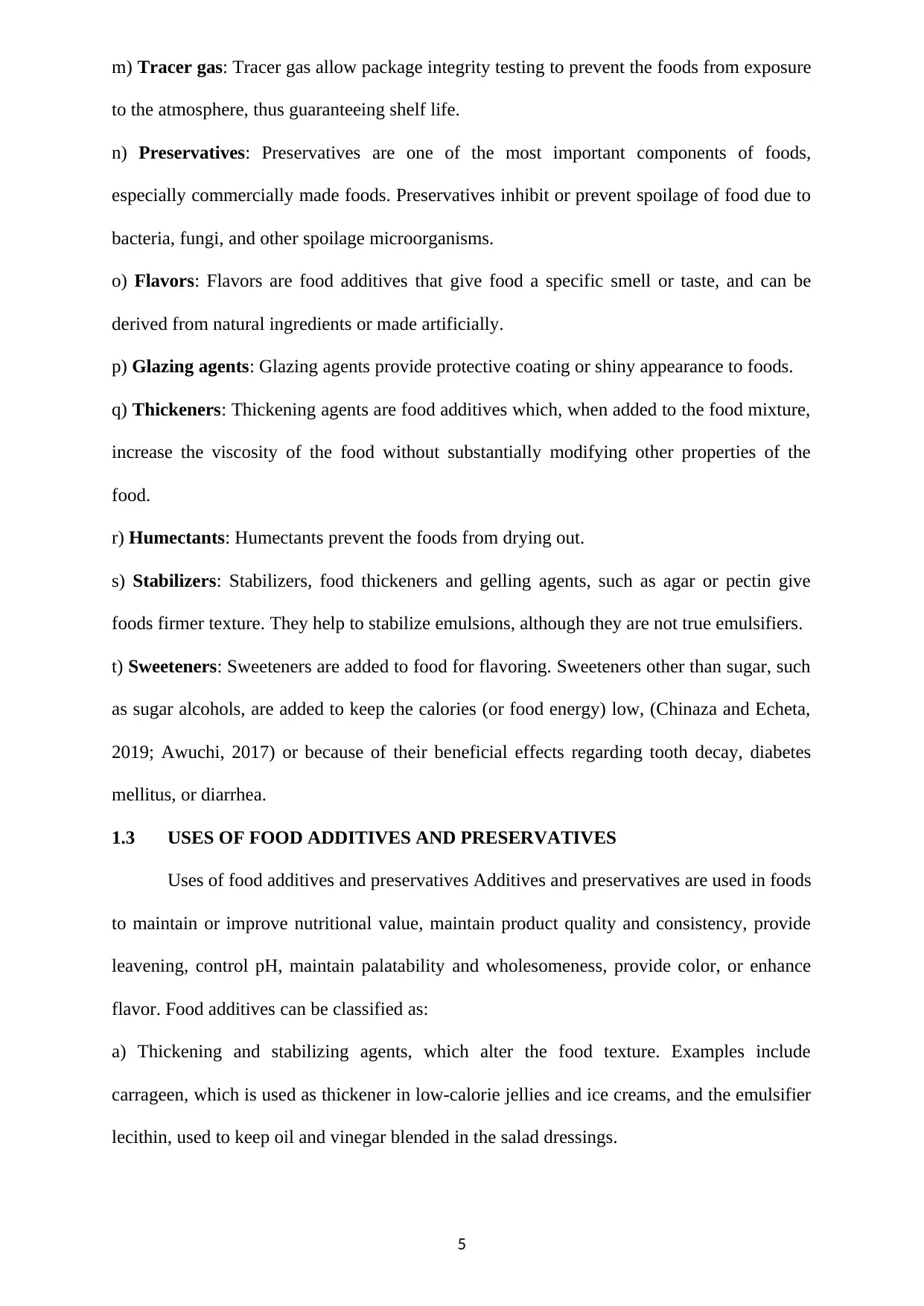
m) Tracer gas: Tracer gas allow package integrity testing to prevent the foods from exposure
to the atmosphere, thus guaranteeing shelf life.
n) Preservatives: Preservatives are one of the most important components of foods,
especially commercially made foods. Preservatives inhibit or prevent spoilage of food due to
bacteria, fungi, and other spoilage microorganisms.
o) Flavors: Flavors are food additives that give food a specific smell or taste, and can be
derived from natural ingredients or made artificially.
p) Glazing agents: Glazing agents provide protective coating or shiny appearance to foods.
q) Thickeners: Thickening agents are food additives which, when added to the food mixture,
increase the viscosity of the food without substantially modifying other properties of the
food.
r) Humectants: Humectants prevent the foods from drying out.
s) Stabilizers: Stabilizers, food thickeners and gelling agents, such as agar or pectin give
foods firmer texture. They help to stabilize emulsions, although they are not true emulsifiers.
t) Sweeteners: Sweeteners are added to food for flavoring. Sweeteners other than sugar, such
as sugar alcohols, are added to keep the calories (or food energy) low, (Chinaza and Echeta,
2019; Awuchi, 2017) or because of their beneficial effects regarding tooth decay, diabetes
mellitus, or diarrhea.
1.3 USES OF FOOD ADDITIVES AND PRESERVATIVES
Uses of food additives and preservatives Additives and preservatives are used in foods
to maintain or improve nutritional value, maintain product quality and consistency, provide
leavening, control pH, maintain palatability and wholesomeness, provide color, or enhance
flavor. Food additives can be classified as:
a) Thickening and stabilizing agents, which alter the food texture. Examples include
carrageen, which is used as thickener in low-calorie jellies and ice creams, and the emulsifier
lecithin, used to keep oil and vinegar blended in the salad dressings.
5
to the atmosphere, thus guaranteeing shelf life.
n) Preservatives: Preservatives are one of the most important components of foods,
especially commercially made foods. Preservatives inhibit or prevent spoilage of food due to
bacteria, fungi, and other spoilage microorganisms.
o) Flavors: Flavors are food additives that give food a specific smell or taste, and can be
derived from natural ingredients or made artificially.
p) Glazing agents: Glazing agents provide protective coating or shiny appearance to foods.
q) Thickeners: Thickening agents are food additives which, when added to the food mixture,
increase the viscosity of the food without substantially modifying other properties of the
food.
r) Humectants: Humectants prevent the foods from drying out.
s) Stabilizers: Stabilizers, food thickeners and gelling agents, such as agar or pectin give
foods firmer texture. They help to stabilize emulsions, although they are not true emulsifiers.
t) Sweeteners: Sweeteners are added to food for flavoring. Sweeteners other than sugar, such
as sugar alcohols, are added to keep the calories (or food energy) low, (Chinaza and Echeta,
2019; Awuchi, 2017) or because of their beneficial effects regarding tooth decay, diabetes
mellitus, or diarrhea.
1.3 USES OF FOOD ADDITIVES AND PRESERVATIVES
Uses of food additives and preservatives Additives and preservatives are used in foods
to maintain or improve nutritional value, maintain product quality and consistency, provide
leavening, control pH, maintain palatability and wholesomeness, provide color, or enhance
flavor. Food additives can be classified as:
a) Thickening and stabilizing agents, which alter the food texture. Examples include
carrageen, which is used as thickener in low-calorie jellies and ice creams, and the emulsifier
lecithin, used to keep oil and vinegar blended in the salad dressings.
5
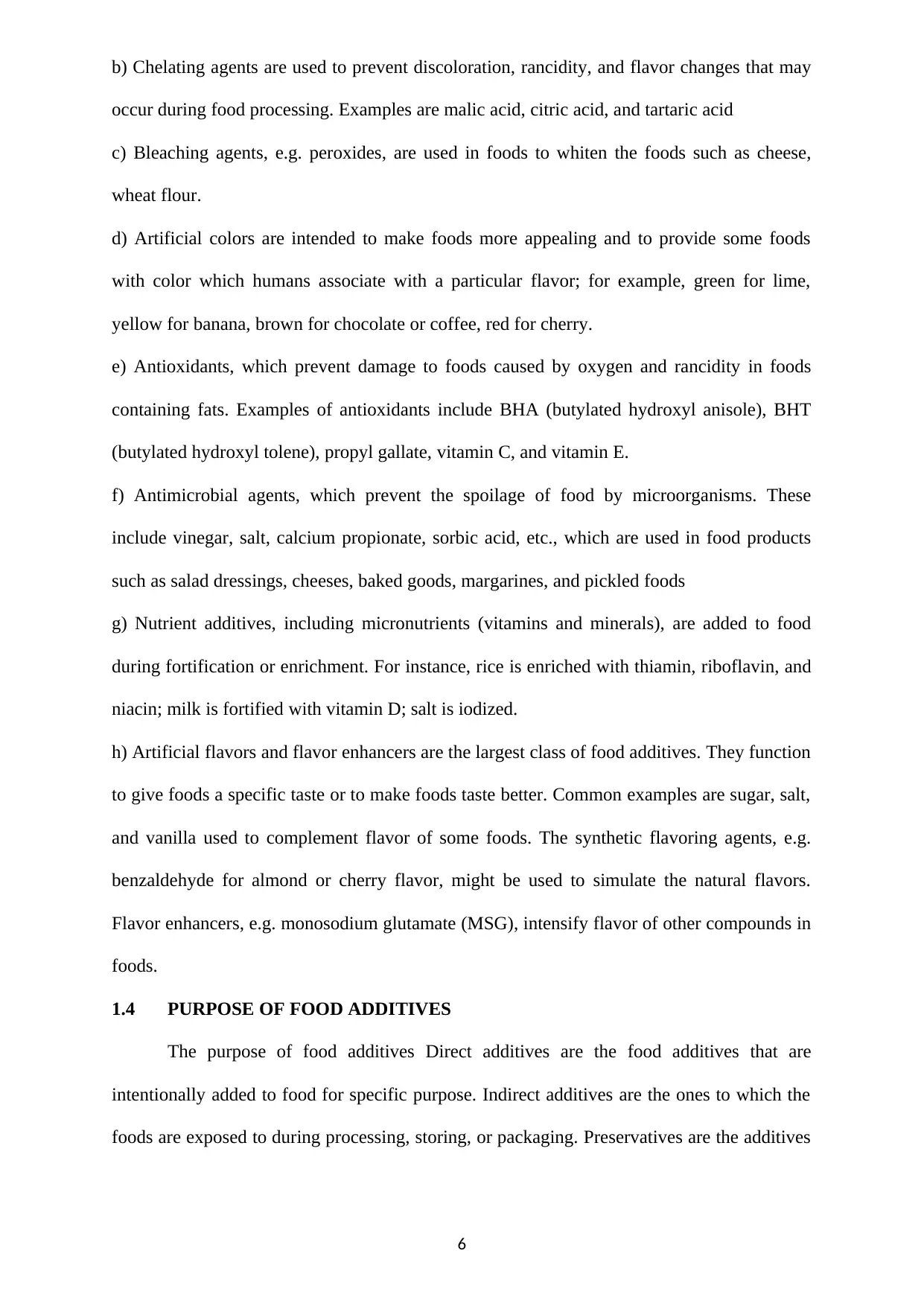
b) Chelating agents are used to prevent discoloration, rancidity, and flavor changes that may
occur during food processing. Examples are malic acid, citric acid, and tartaric acid
c) Bleaching agents, e.g. peroxides, are used in foods to whiten the foods such as cheese,
wheat flour.
d) Artificial colors are intended to make foods more appealing and to provide some foods
with color which humans associate with a particular flavor; for example, green for lime,
yellow for banana, brown for chocolate or coffee, red for cherry.
e) Antioxidants, which prevent damage to foods caused by oxygen and rancidity in foods
containing fats. Examples of antioxidants include BHA (butylated hydroxyl anisole), BHT
(butylated hydroxyl tolene), propyl gallate, vitamin C, and vitamin E.
f) Antimicrobial agents, which prevent the spoilage of food by microorganisms. These
include vinegar, salt, calcium propionate, sorbic acid, etc., which are used in food products
such as salad dressings, cheeses, baked goods, margarines, and pickled foods
g) Nutrient additives, including micronutrients (vitamins and minerals), are added to food
during fortification or enrichment. For instance, rice is enriched with thiamin, riboflavin, and
niacin; milk is fortified with vitamin D; salt is iodized.
h) Artificial flavors and flavor enhancers are the largest class of food additives. They function
to give foods a specific taste or to make foods taste better. Common examples are sugar, salt,
and vanilla used to complement flavor of some foods. The synthetic flavoring agents, e.g.
benzaldehyde for almond or cherry flavor, might be used to simulate the natural flavors.
Flavor enhancers, e.g. monosodium glutamate (MSG), intensify flavor of other compounds in
foods.
1.4 PURPOSE OF FOOD ADDITIVES
The purpose of food additives Direct additives are the food additives that are
intentionally added to food for specific purpose. Indirect additives are the ones to which the
foods are exposed to during processing, storing, or packaging. Preservatives are the additives
6
occur during food processing. Examples are malic acid, citric acid, and tartaric acid
c) Bleaching agents, e.g. peroxides, are used in foods to whiten the foods such as cheese,
wheat flour.
d) Artificial colors are intended to make foods more appealing and to provide some foods
with color which humans associate with a particular flavor; for example, green for lime,
yellow for banana, brown for chocolate or coffee, red for cherry.
e) Antioxidants, which prevent damage to foods caused by oxygen and rancidity in foods
containing fats. Examples of antioxidants include BHA (butylated hydroxyl anisole), BHT
(butylated hydroxyl tolene), propyl gallate, vitamin C, and vitamin E.
f) Antimicrobial agents, which prevent the spoilage of food by microorganisms. These
include vinegar, salt, calcium propionate, sorbic acid, etc., which are used in food products
such as salad dressings, cheeses, baked goods, margarines, and pickled foods
g) Nutrient additives, including micronutrients (vitamins and minerals), are added to food
during fortification or enrichment. For instance, rice is enriched with thiamin, riboflavin, and
niacin; milk is fortified with vitamin D; salt is iodized.
h) Artificial flavors and flavor enhancers are the largest class of food additives. They function
to give foods a specific taste or to make foods taste better. Common examples are sugar, salt,
and vanilla used to complement flavor of some foods. The synthetic flavoring agents, e.g.
benzaldehyde for almond or cherry flavor, might be used to simulate the natural flavors.
Flavor enhancers, e.g. monosodium glutamate (MSG), intensify flavor of other compounds in
foods.
1.4 PURPOSE OF FOOD ADDITIVES
The purpose of food additives Direct additives are the food additives that are
intentionally added to food for specific purpose. Indirect additives are the ones to which the
foods are exposed to during processing, storing, or packaging. Preservatives are the additives
6
⊘ This is a preview!⊘
Do you want full access?
Subscribe today to unlock all pages.

Trusted by 1+ million students worldwide
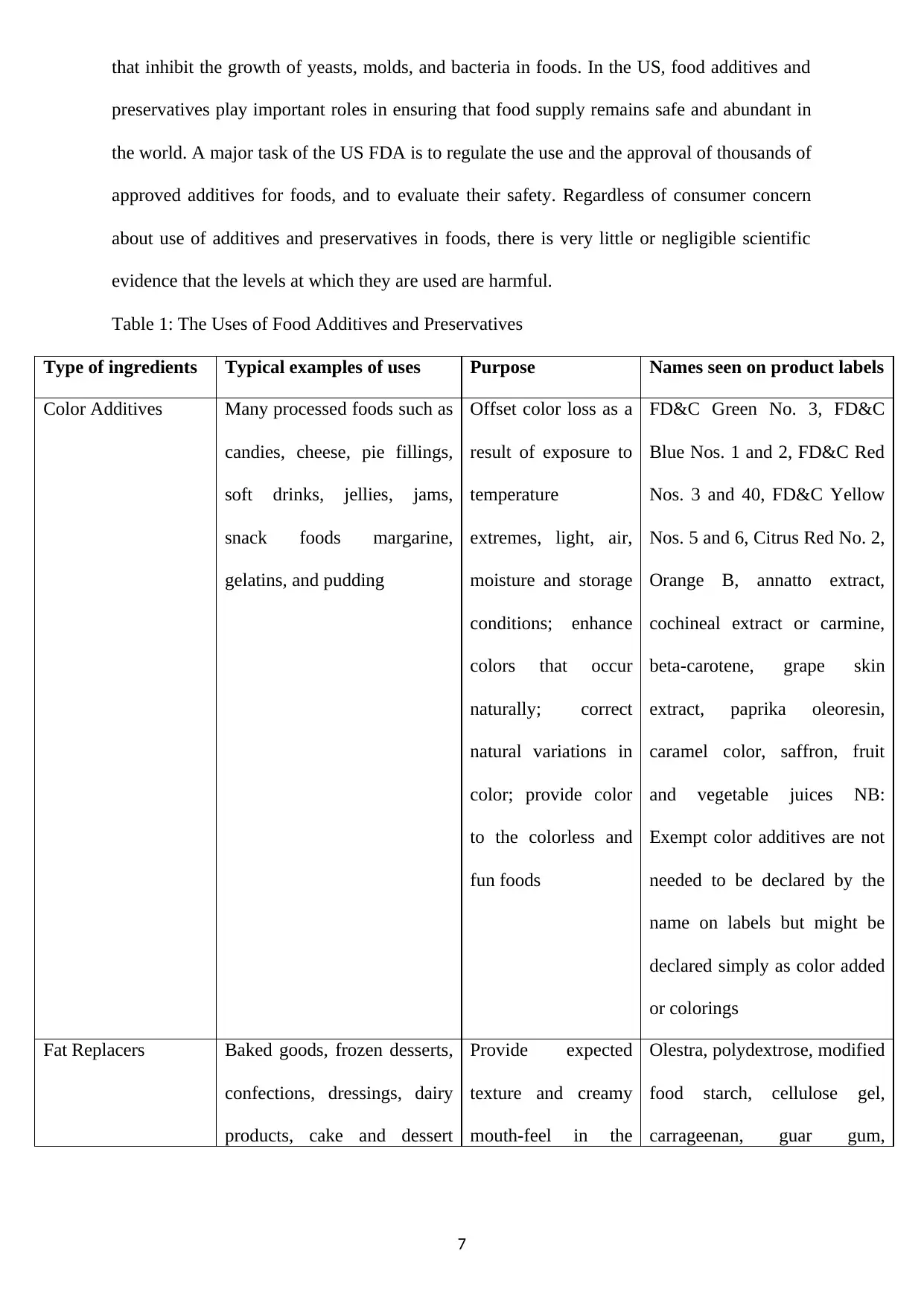
that inhibit the growth of yeasts, molds, and bacteria in foods. In the US, food additives and
preservatives play important roles in ensuring that food supply remains safe and abundant in
the world. A major task of the US FDA is to regulate the use and the approval of thousands of
approved additives for foods, and to evaluate their safety. Regardless of consumer concern
about use of additives and preservatives in foods, there is very little or negligible scientific
evidence that the levels at which they are used are harmful.
Table 1: The Uses of Food Additives and Preservatives
Type of ingredients Typical examples of uses Purpose Names seen on product labels
Color Additives Many processed foods such as
candies, cheese, pie fillings,
soft drinks, jellies, jams,
snack foods margarine,
gelatins, and pudding
Offset color loss as a
result of exposure to
temperature
extremes, light, air,
moisture and storage
conditions; enhance
colors that occur
naturally; correct
natural variations in
color; provide color
to the colorless and
fun foods
FD&C Green No. 3, FD&C
Blue Nos. 1 and 2, FD&C Red
Nos. 3 and 40, FD&C Yellow
Nos. 5 and 6, Citrus Red No. 2,
Orange B, annatto extract,
cochineal extract or carmine,
beta-carotene, grape skin
extract, paprika oleoresin,
caramel color, saffron, fruit
and vegetable juices NB:
Exempt color additives are not
needed to be declared by the
name on labels but might be
declared simply as color added
or colorings
Fat Replacers Baked goods, frozen desserts,
confections, dressings, dairy
products, cake and dessert
Provide expected
texture and creamy
mouth-feel in the
Olestra, polydextrose, modified
food starch, cellulose gel,
carrageenan, guar gum,
7
preservatives play important roles in ensuring that food supply remains safe and abundant in
the world. A major task of the US FDA is to regulate the use and the approval of thousands of
approved additives for foods, and to evaluate their safety. Regardless of consumer concern
about use of additives and preservatives in foods, there is very little or negligible scientific
evidence that the levels at which they are used are harmful.
Table 1: The Uses of Food Additives and Preservatives
Type of ingredients Typical examples of uses Purpose Names seen on product labels
Color Additives Many processed foods such as
candies, cheese, pie fillings,
soft drinks, jellies, jams,
snack foods margarine,
gelatins, and pudding
Offset color loss as a
result of exposure to
temperature
extremes, light, air,
moisture and storage
conditions; enhance
colors that occur
naturally; correct
natural variations in
color; provide color
to the colorless and
fun foods
FD&C Green No. 3, FD&C
Blue Nos. 1 and 2, FD&C Red
Nos. 3 and 40, FD&C Yellow
Nos. 5 and 6, Citrus Red No. 2,
Orange B, annatto extract,
cochineal extract or carmine,
beta-carotene, grape skin
extract, paprika oleoresin,
caramel color, saffron, fruit
and vegetable juices NB:
Exempt color additives are not
needed to be declared by the
name on labels but might be
declared simply as color added
or colorings
Fat Replacers Baked goods, frozen desserts,
confections, dressings, dairy
products, cake and dessert
Provide expected
texture and creamy
mouth-feel in the
Olestra, polydextrose, modified
food starch, cellulose gel,
carrageenan, guar gum,
7
Paraphrase This Document
Need a fresh take? Get an instant paraphrase of this document with our AI Paraphraser
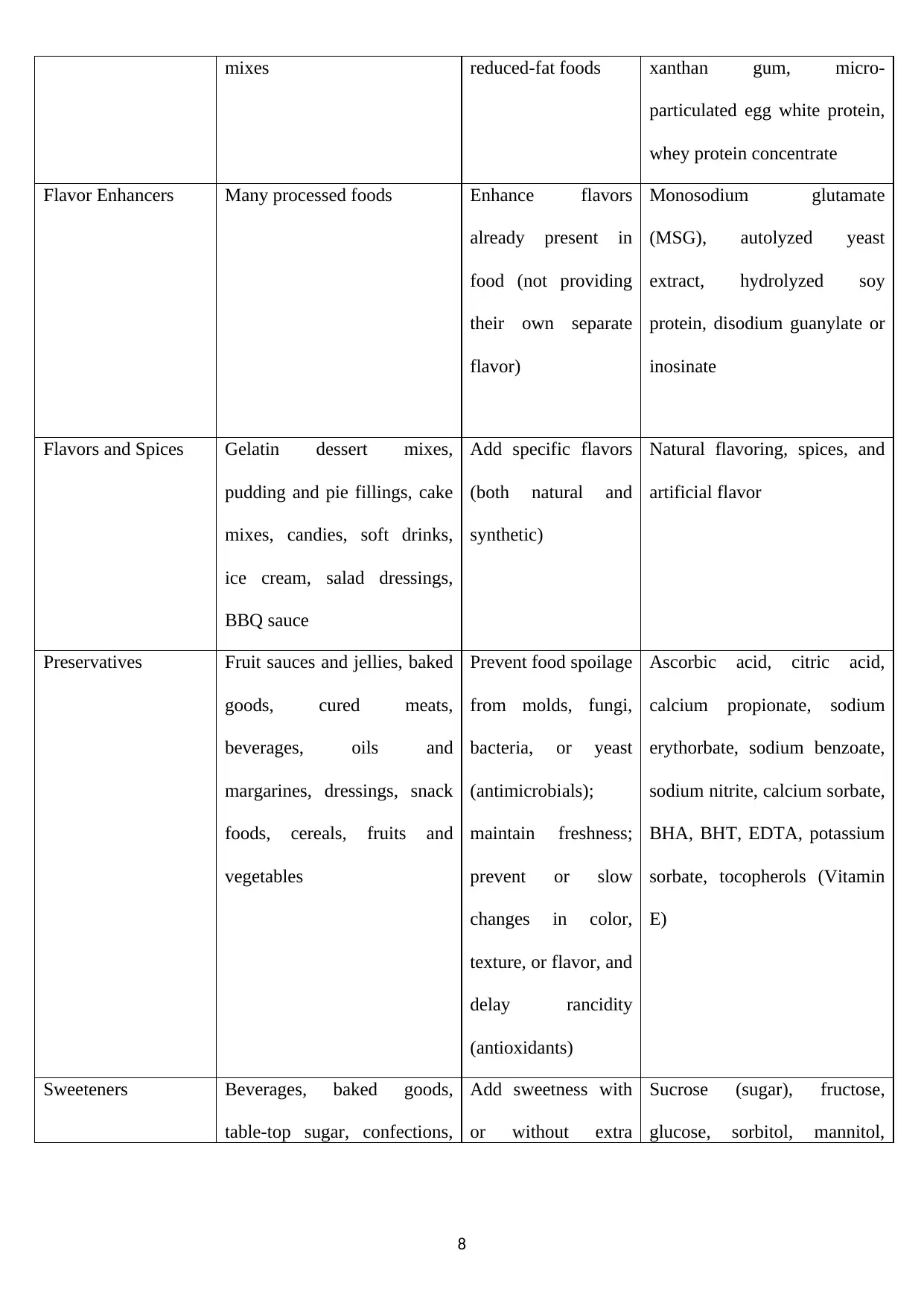
mixes reduced-fat foods xanthan gum, micro-
particulated egg white protein,
whey protein concentrate
Flavor Enhancers Many processed foods Enhance flavors
already present in
food (not providing
their own separate
flavor)
Monosodium glutamate
(MSG), autolyzed yeast
extract, hydrolyzed soy
protein, disodium guanylate or
inosinate
Flavors and Spices Gelatin dessert mixes,
pudding and pie fillings, cake
mixes, candies, soft drinks,
ice cream, salad dressings,
BBQ sauce
Add specific flavors
(both natural and
synthetic)
Natural flavoring, spices, and
artificial flavor
Preservatives Fruit sauces and jellies, baked
goods, cured meats,
beverages, oils and
margarines, dressings, snack
foods, cereals, fruits and
vegetables
Prevent food spoilage
from molds, fungi,
bacteria, or yeast
(antimicrobials);
maintain freshness;
prevent or slow
changes in color,
texture, or flavor, and
delay rancidity
(antioxidants)
Ascorbic acid, citric acid,
calcium propionate, sodium
erythorbate, sodium benzoate,
sodium nitrite, calcium sorbate,
BHA, BHT, EDTA, potassium
sorbate, tocopherols (Vitamin
E)
Sweeteners Beverages, baked goods,
table-top sugar, confections,
Add sweetness with
or without extra
Sucrose (sugar), fructose,
glucose, sorbitol, mannitol,
8
particulated egg white protein,
whey protein concentrate
Flavor Enhancers Many processed foods Enhance flavors
already present in
food (not providing
their own separate
flavor)
Monosodium glutamate
(MSG), autolyzed yeast
extract, hydrolyzed soy
protein, disodium guanylate or
inosinate
Flavors and Spices Gelatin dessert mixes,
pudding and pie fillings, cake
mixes, candies, soft drinks,
ice cream, salad dressings,
BBQ sauce
Add specific flavors
(both natural and
synthetic)
Natural flavoring, spices, and
artificial flavor
Preservatives Fruit sauces and jellies, baked
goods, cured meats,
beverages, oils and
margarines, dressings, snack
foods, cereals, fruits and
vegetables
Prevent food spoilage
from molds, fungi,
bacteria, or yeast
(antimicrobials);
maintain freshness;
prevent or slow
changes in color,
texture, or flavor, and
delay rancidity
(antioxidants)
Ascorbic acid, citric acid,
calcium propionate, sodium
erythorbate, sodium benzoate,
sodium nitrite, calcium sorbate,
BHA, BHT, EDTA, potassium
sorbate, tocopherols (Vitamin
E)
Sweeteners Beverages, baked goods,
table-top sugar, confections,
Add sweetness with
or without extra
Sucrose (sugar), fructose,
glucose, sorbitol, mannitol,
8

substitutes, many processed
foods
calories high fructose corn syrup,
sucralose, corn syrup,
saccharin, aspartame, neotame,
acesulfame potassium
(acesulfame-K)
9
foods
calories high fructose corn syrup,
sucralose, corn syrup,
saccharin, aspartame, neotame,
acesulfame potassium
(acesulfame-K)
9
⊘ This is a preview!⊘
Do you want full access?
Subscribe today to unlock all pages.

Trusted by 1+ million students worldwide
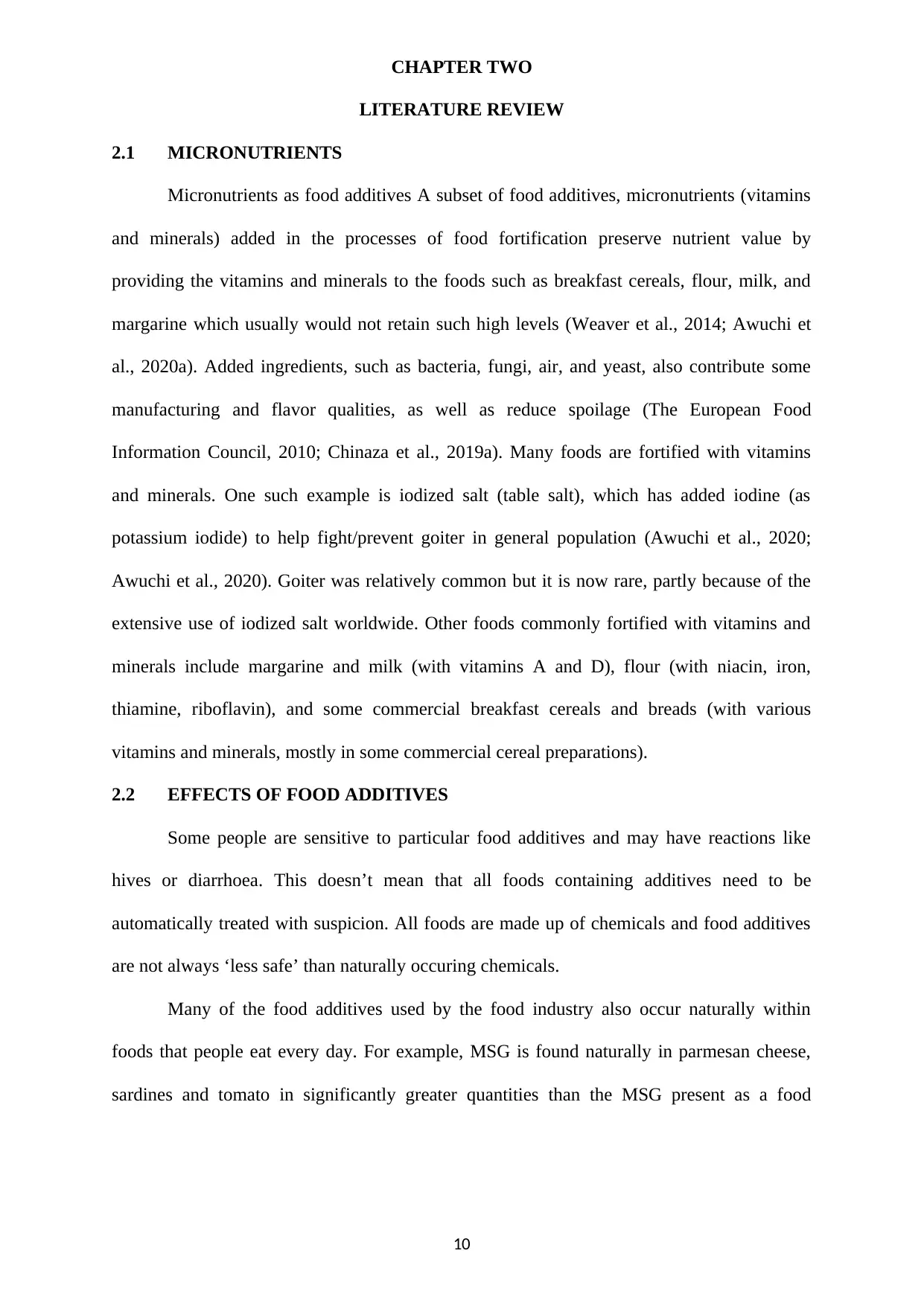
CHAPTER TWO
LITERATURE REVIEW
2.1 MICRONUTRIENTS
Micronutrients as food additives A subset of food additives, micronutrients (vitamins
and minerals) added in the processes of food fortification preserve nutrient value by
providing the vitamins and minerals to the foods such as breakfast cereals, flour, milk, and
margarine which usually would not retain such high levels (Weaver et al., 2014; Awuchi et
al., 2020a). Added ingredients, such as bacteria, fungi, air, and yeast, also contribute some
manufacturing and flavor qualities, as well as reduce spoilage (The European Food
Information Council, 2010; Chinaza et al., 2019a). Many foods are fortified with vitamins
and minerals. One such example is iodized salt (table salt), which has added iodine (as
potassium iodide) to help fight/prevent goiter in general population (Awuchi et al., 2020;
Awuchi et al., 2020). Goiter was relatively common but it is now rare, partly because of the
extensive use of iodized salt worldwide. Other foods commonly fortified with vitamins and
minerals include margarine and milk (with vitamins A and D), flour (with niacin, iron,
thiamine, riboflavin), and some commercial breakfast cereals and breads (with various
vitamins and minerals, mostly in some commercial cereal preparations).
2.2 EFFECTS OF FOOD ADDITIVES
Some people are sensitive to particular food additives and may have reactions like
hives or diarrhoea. This doesn’t mean that all foods containing additives need to be
automatically treated with suspicion. All foods are made up of chemicals and food additives
are not always ‘less safe’ than naturally occuring chemicals.
Many of the food additives used by the food industry also occur naturally within
foods that people eat every day. For example, MSG is found naturally in parmesan cheese,
sardines and tomato in significantly greater quantities than the MSG present as a food
10
LITERATURE REVIEW
2.1 MICRONUTRIENTS
Micronutrients as food additives A subset of food additives, micronutrients (vitamins
and minerals) added in the processes of food fortification preserve nutrient value by
providing the vitamins and minerals to the foods such as breakfast cereals, flour, milk, and
margarine which usually would not retain such high levels (Weaver et al., 2014; Awuchi et
al., 2020a). Added ingredients, such as bacteria, fungi, air, and yeast, also contribute some
manufacturing and flavor qualities, as well as reduce spoilage (The European Food
Information Council, 2010; Chinaza et al., 2019a). Many foods are fortified with vitamins
and minerals. One such example is iodized salt (table salt), which has added iodine (as
potassium iodide) to help fight/prevent goiter in general population (Awuchi et al., 2020;
Awuchi et al., 2020). Goiter was relatively common but it is now rare, partly because of the
extensive use of iodized salt worldwide. Other foods commonly fortified with vitamins and
minerals include margarine and milk (with vitamins A and D), flour (with niacin, iron,
thiamine, riboflavin), and some commercial breakfast cereals and breads (with various
vitamins and minerals, mostly in some commercial cereal preparations).
2.2 EFFECTS OF FOOD ADDITIVES
Some people are sensitive to particular food additives and may have reactions like
hives or diarrhoea. This doesn’t mean that all foods containing additives need to be
automatically treated with suspicion. All foods are made up of chemicals and food additives
are not always ‘less safe’ than naturally occuring chemicals.
Many of the food additives used by the food industry also occur naturally within
foods that people eat every day. For example, MSG is found naturally in parmesan cheese,
sardines and tomato in significantly greater quantities than the MSG present as a food
10
Paraphrase This Document
Need a fresh take? Get an instant paraphrase of this document with our AI Paraphraser
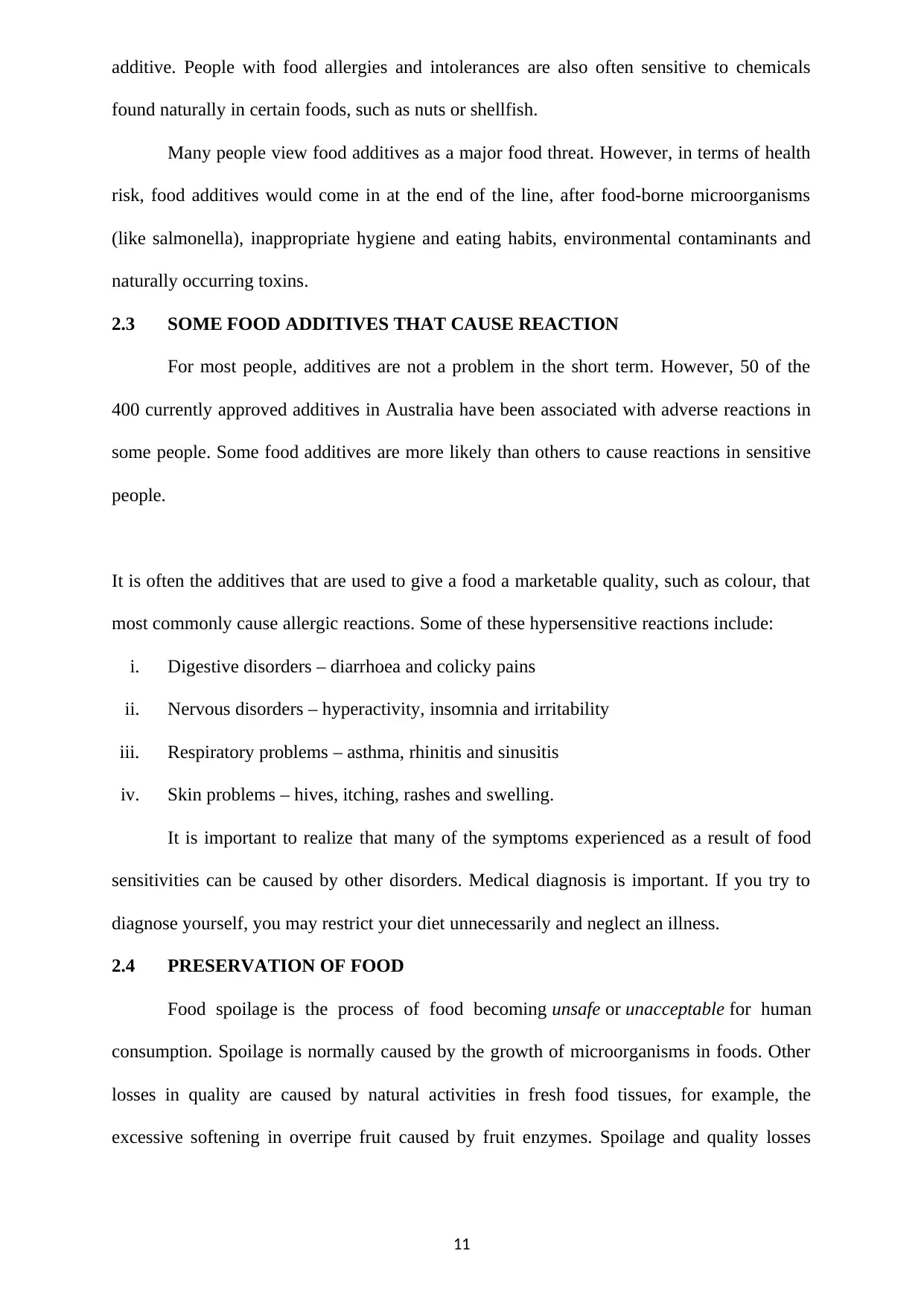
additive. People with food allergies and intolerances are also often sensitive to chemicals
found naturally in certain foods, such as nuts or shellfish.
Many people view food additives as a major food threat. However, in terms of health
risk, food additives would come in at the end of the line, after food-borne microorganisms
(like salmonella), inappropriate hygiene and eating habits, environmental contaminants and
naturally occurring toxins.
2.3 SOME FOOD ADDITIVES THAT CAUSE REACTION
For most people, additives are not a problem in the short term. However, 50 of the
400 currently approved additives in Australia have been associated with adverse reactions in
some people. Some food additives are more likely than others to cause reactions in sensitive
people.
It is often the additives that are used to give a food a marketable quality, such as colour, that
most commonly cause allergic reactions. Some of these hypersensitive reactions include:
i. Digestive disorders – diarrhoea and colicky pains
ii. Nervous disorders – hyperactivity, insomnia and irritability
iii. Respiratory problems – asthma, rhinitis and sinusitis
iv. Skin problems – hives, itching, rashes and swelling.
It is important to realize that many of the symptoms experienced as a result of food
sensitivities can be caused by other disorders. Medical diagnosis is important. If you try to
diagnose yourself, you may restrict your diet unnecessarily and neglect an illness.
2.4 PRESERVATION OF FOOD
Food spoilage is the process of food becoming unsafe or unacceptable for human
consumption. Spoilage is normally caused by the growth of microorganisms in foods. Other
losses in quality are caused by natural activities in fresh food tissues, for example, the
excessive softening in overripe fruit caused by fruit enzymes. Spoilage and quality losses
11
found naturally in certain foods, such as nuts or shellfish.
Many people view food additives as a major food threat. However, in terms of health
risk, food additives would come in at the end of the line, after food-borne microorganisms
(like salmonella), inappropriate hygiene and eating habits, environmental contaminants and
naturally occurring toxins.
2.3 SOME FOOD ADDITIVES THAT CAUSE REACTION
For most people, additives are not a problem in the short term. However, 50 of the
400 currently approved additives in Australia have been associated with adverse reactions in
some people. Some food additives are more likely than others to cause reactions in sensitive
people.
It is often the additives that are used to give a food a marketable quality, such as colour, that
most commonly cause allergic reactions. Some of these hypersensitive reactions include:
i. Digestive disorders – diarrhoea and colicky pains
ii. Nervous disorders – hyperactivity, insomnia and irritability
iii. Respiratory problems – asthma, rhinitis and sinusitis
iv. Skin problems – hives, itching, rashes and swelling.
It is important to realize that many of the symptoms experienced as a result of food
sensitivities can be caused by other disorders. Medical diagnosis is important. If you try to
diagnose yourself, you may restrict your diet unnecessarily and neglect an illness.
2.4 PRESERVATION OF FOOD
Food spoilage is the process of food becoming unsafe or unacceptable for human
consumption. Spoilage is normally caused by the growth of microorganisms in foods. Other
losses in quality are caused by natural activities in fresh food tissues, for example, the
excessive softening in overripe fruit caused by fruit enzymes. Spoilage and quality losses
11
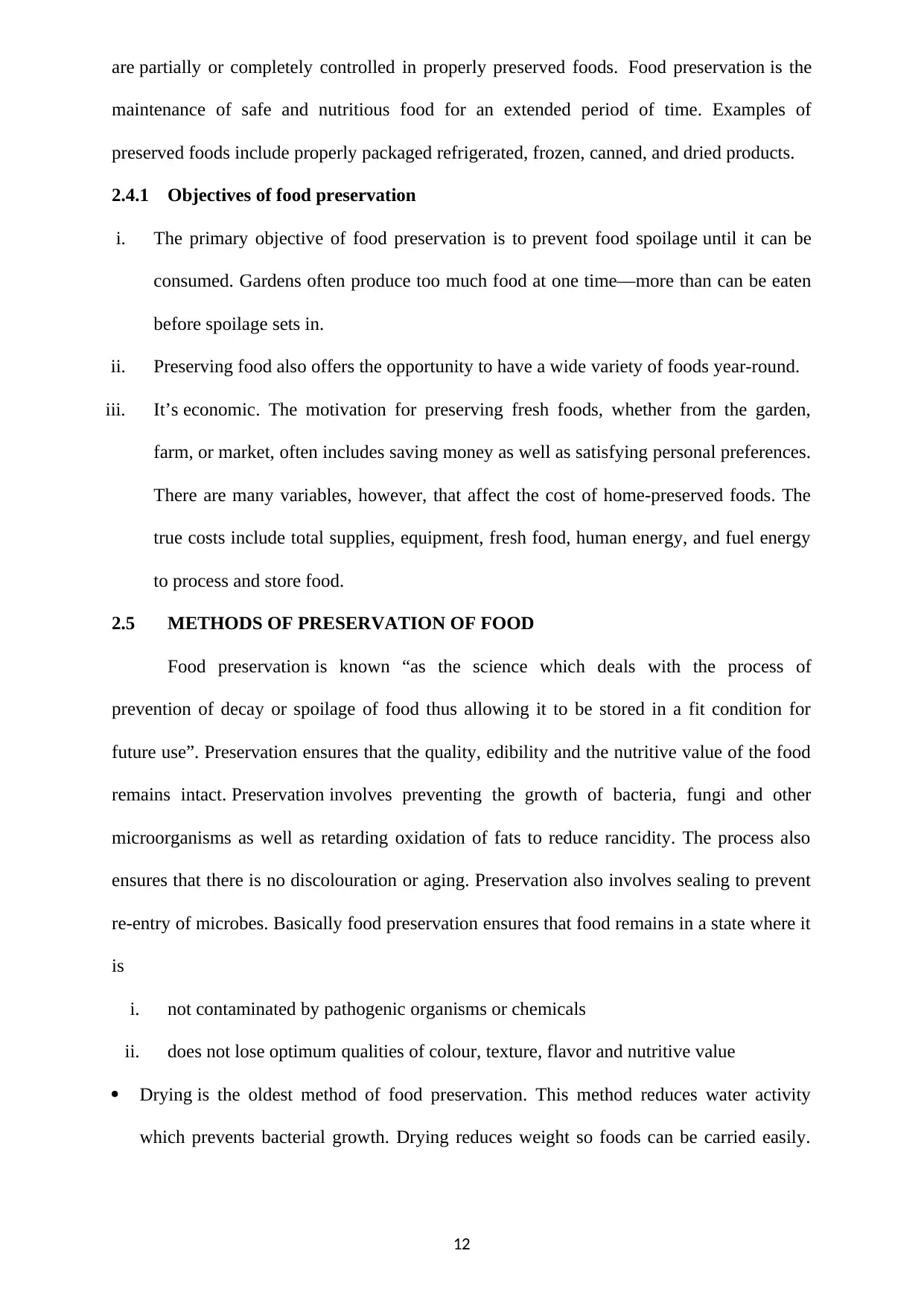
are partially or completely controlled in properly preserved foods. Food preservation is the
maintenance of safe and nutritious food for an extended period of time. Examples of
preserved foods include properly packaged refrigerated, frozen, canned, and dried products.
2.4.1 Objectives of food preservation
i. The primary objective of food preservation is to prevent food spoilage until it can be
consumed. Gardens often produce too much food at one time—more than can be eaten
before spoilage sets in.
ii. Preserving food also offers the opportunity to have a wide variety of foods year-round.
iii. It’s economic. The motivation for preserving fresh foods, whether from the garden,
farm, or market, often includes saving money as well as satisfying personal preferences.
There are many variables, however, that affect the cost of home-preserved foods. The
true costs include total supplies, equipment, fresh food, human energy, and fuel energy
to process and store food.
2.5 METHODS OF PRESERVATION OF FOOD
Food preservation is known “as the science which deals with the process of
prevention of decay or spoilage of food thus allowing it to be stored in a fit condition for
future use”. Preservation ensures that the quality, edibility and the nutritive value of the food
remains intact. Preservation involves preventing the growth of bacteria, fungi and other
microorganisms as well as retarding oxidation of fats to reduce rancidity. The process also
ensures that there is no discolouration or aging. Preservation also involves sealing to prevent
re-entry of microbes. Basically food preservation ensures that food remains in a state where it
is
i. not contaminated by pathogenic organisms or chemicals
ii. does not lose optimum qualities of colour, texture, flavor and nutritive value
Drying is the oldest method of food preservation. This method reduces water activity
which prevents bacterial growth. Drying reduces weight so foods can be carried easily.
12
maintenance of safe and nutritious food for an extended period of time. Examples of
preserved foods include properly packaged refrigerated, frozen, canned, and dried products.
2.4.1 Objectives of food preservation
i. The primary objective of food preservation is to prevent food spoilage until it can be
consumed. Gardens often produce too much food at one time—more than can be eaten
before spoilage sets in.
ii. Preserving food also offers the opportunity to have a wide variety of foods year-round.
iii. It’s economic. The motivation for preserving fresh foods, whether from the garden,
farm, or market, often includes saving money as well as satisfying personal preferences.
There are many variables, however, that affect the cost of home-preserved foods. The
true costs include total supplies, equipment, fresh food, human energy, and fuel energy
to process and store food.
2.5 METHODS OF PRESERVATION OF FOOD
Food preservation is known “as the science which deals with the process of
prevention of decay or spoilage of food thus allowing it to be stored in a fit condition for
future use”. Preservation ensures that the quality, edibility and the nutritive value of the food
remains intact. Preservation involves preventing the growth of bacteria, fungi and other
microorganisms as well as retarding oxidation of fats to reduce rancidity. The process also
ensures that there is no discolouration or aging. Preservation also involves sealing to prevent
re-entry of microbes. Basically food preservation ensures that food remains in a state where it
is
i. not contaminated by pathogenic organisms or chemicals
ii. does not lose optimum qualities of colour, texture, flavor and nutritive value
Drying is the oldest method of food preservation. This method reduces water activity
which prevents bacterial growth. Drying reduces weight so foods can be carried easily.
12
⊘ This is a preview!⊘
Do you want full access?
Subscribe today to unlock all pages.

Trusted by 1+ million students worldwide
1 out of 26
Your All-in-One AI-Powered Toolkit for Academic Success.
+13062052269
info@desklib.com
Available 24*7 on WhatsApp / Email
![[object Object]](/_next/static/media/star-bottom.7253800d.svg)
Unlock your academic potential
Copyright © 2020–2025 A2Z Services. All Rights Reserved. Developed and managed by ZUCOL.